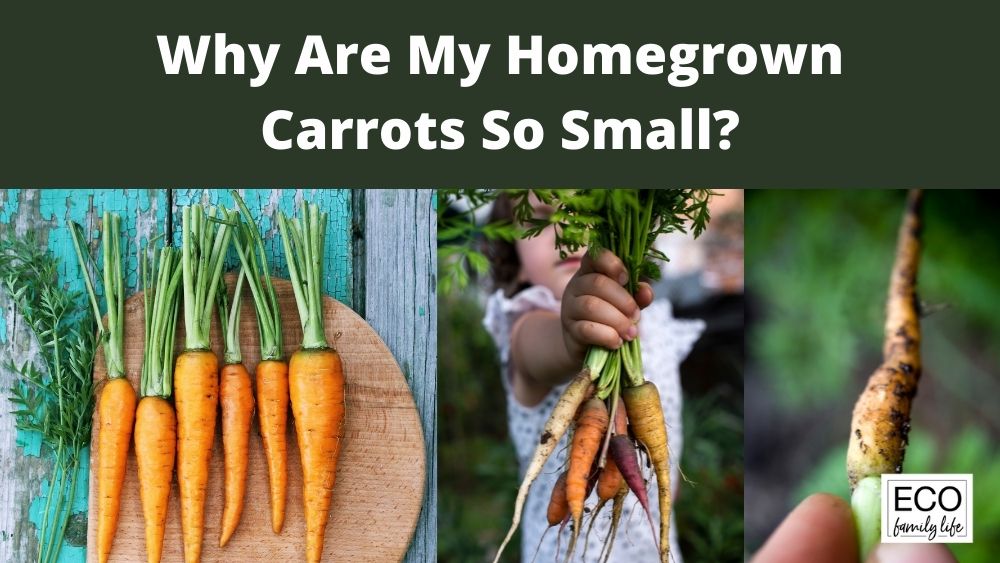Growing carrots at home is fun and a great way to get kids into gardening. Small homegrown carrots can be caused by one of three things: you didn’t thin them during the growing season, your soil is too heavy, or you gave the carrots too much nitrogen. Fortunately, there’s an easy fix for all three of these causes.
Growing carrots is as much an art as a science, thin them out regularly, water them well, till the soil to remove any large lumps or rocks and plant them in a sunny position. All of these tips will give you longer and bigger carrots ready for a tasty salad or homemade stew.

This article will explore why homegrown carrots stay small, how to grow them bigger and tips for delicious carrots.
Why carrots stay small and how to grow them bigger
Here are 3 easy ways to grow bigger carrots at home. These tips are simple, low cost to implement and will help to prevent growing loads of small tasteless carrots.
1. Thinning out the carrots as they grow
When you buy carrot seeds, there are always tons of them for you to plant. If you plant too many of them too close together, they’ll be in competition with one another for water and nutrients resulting in small carrots.
This is why thinning out the carrots is necessary, but it isn’t as difficult as you think. It simply means removing some of the carrots so that the remaining ones have enough physical space to grow and get healthy. If this doesn’t happen, the carrots won’t get as big as they should.
To thin out your carrots gently pluck out every second or third carrot to make more space. You may need to repeat this again as the carrots get bigger. Even small carrots are great in salad so don’t throw them out.
Many growers remove two carrots and leave the third one there, then continue the cycle across all of the rows until they’re done. If you do this, you’ll end up with carrots that have enough room to grow. Usually, you’ll find you need to thin out your carrots at least twice during the growing season, and maybe even three times.
2. Soil that is too heavy
Like all other veggies, carrots need excellent soil to grow to the size they should be. Keep in mind that carrots are biennial, which means they grow their top growth in the first year and then store up energy.
In the second year, the carrots themselves grow, and that stored-up energy goes into flowering and making seeds next. So, in essence, when we eat a carrot, we’re eating the plant’s stored energy for the following year.
If you want to grow long carrots, you’ll need loose, friable soil for the roots to be able to push through it. Your soil needs to be fairly light for this to happen, so if you have sandy soil, add some homemade garden compost to it to make it lighter and easier for the carrots to move around.
Adding compost to the soil is a great way to lighten the soil keep soil moisture in for longer and feed soil bacteria. Rotate the location of your carrot crop year to year to make sure they have the nutrients they need.
3. Giving the carrots too much nitrogen
Nitrogen is essential for green leafy vegetables growth but there is such a thing as adding too much nitrogen to the soil for carrots. Nitrogen is important for the growth of the leafy sections of your carrot plant, but if the leafy sections are healthy and the rest of the crop isn’t, you likely added too much nitrogen to the mix.
Avoid adding too much pelleted chicken manure or slow release nitrogen fertilizer. If you decide to fertilize your carrots, make sure you use a balanced fertilizer with equal amounts of nitrogen, phosphorus, and potassium (NPK), and not one that has more nitrogen than it does the other minerals.
Bone meal is great to add to your carrot plants because it is good for root growth, which is what the carrot itself actually is. So while fertilization of the soil is fine, using fertilizer with too much nitrogen in it is not.
4. Regular water
Another important detail when growing carrots is how much to water them. You can’t just add a touch of water to the top of the soil and nothing else. Carrots need to have moisture deep down into the soil.
Water carrots long and slow so that the water goes down deep enough to cover the entire carrot. You want the water to penetrate the soil and reach the lower parts of the carrot roots.
For more on how to grow big carrots, check out this video.
Conclusion
When it comes to growing long slender carrots there are some tricks that make it easier. Thinning out carrots several times during the growing period is necessary, but so is making sure use a balance fertilizer and that the soil is not too heavy.
Carrots need room enough to move around as they grow because they’ll be pushing through the soil as they get bigger.
Carrots are a healthy veggie and taste delicious, and there’s nothing like growing your own. Once you learn what to look for, you’ll be much more successful at growing these tasty vegetables. Preparing the soil and making sure it’s just right in the very beginning is important because this can prevent a lot of problems as the carrots start to grow.
Happy growing.
I am an accredited practicing dietitian, experienced gardener and a dedicated cook. I love writing and sharing my experience so you can learn from my successes and mistakes.
